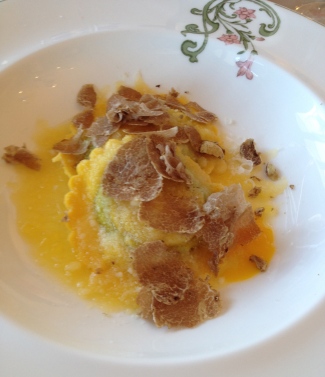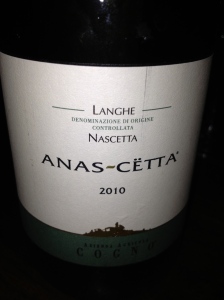In March I went to Vinitaly (the wine fair in Verona) for the first time in 7 years with Nicole and Travis, friends who own a wine store in NYC. They had never been there and wanted to visit a number of producers whose wines they carry in their store. On the top of the list was Valter Fissore of the Elvio Cogno winery.
When we arrived at the Cogno booth we were greeted by Valter and his wife Nadia (Elvio Cogno’s daughter).
We tasted a number of wines including the very rare pre- philloxera Barbera. We had a very enjoyable visit and Valter asked if we were going to visit Piedmont after the fair. We said no but we would be there in November and Valter invited us to visit the winery.
The Elvio Cogno Winery, is situated on the top of Bricco Ravera, a hill near Novello in the Langhe region of Piedmont. I have been to the winery 3 or 4 times and it is always a great experience.
Valter is always trying to tell me or show me something new, and this time was no exception. He took us into the wine cellar and we tasted a number of barrel samples from different vintages and different vineyards. Valter spoke about how the wine differs according to the year and the vintage.
In the cellar there were large oak barrels called botti which contain up to 55 hl that he uses for his Barolo. Smaller barriques extract too much from the wood into the wine. He feels that if there is a long maceration of 40 days for the Barolo it makes the tannins softer.
We sampled the Barolo Ravera 2014 and the Vigna Elena 2012 among others. We also tasted the pre- pre-phylloxera Barbera. This is a very special and limited wine and there is only one barrel.
Barbera d’Alba “PRE-Phylloxera” DOC. Made from 100% Barbera. Valter said that the vineyard is over 120 years old. He rents the vineyard, which is situated in Berri close to La Morra. The vineyard is only 3,400 square meters. The vines are vertically trellised and Guyot pruned and the vineyard is at 520 meters. The grapes are harvested in the beginning of October. The wine is fermented in temperature controlled stainless steel tanks with automatic pump over. Aging takes place for 12 months in a large Slavonia oak cask and there is another 6 months of bottle aging before release. Only 1,800 bottles are produced.
This is an elegant well-balanced wine with hints of raspberry, strawberry and cherry and a touch of spice. It is a Barbera that will age. I have always been very impressed with this wine. Nicole and Travis like this Barbera a lot as does Ed Mc Carthy and Tom Maresca.
Valter explained that the vines come from pre-grafted plants propagated by cuttings maintained over many years so that they have the original Barbera characteristics. The terrain is sandy-chalk, which is a natural protection for the vines from phylloxera.
Valter said that this wine was something he always wanted to do and it is also a tribute to his father-in-law, Elvio Cogno, who made a pre-phylloxera Dolcetto d’Alba “Boschi di Berri” when he was at the Marcarini Winery.
Walter took a picture of the inside of one of the tanks that was filled with red wine must.
Then the cellar man began to remove the must into a small metal box with a rotor, which broke up the must. A long tube transferred the juice into another tank.
Valter showed us some “corks” and explained that he was now going to use an agglomerate cork that allows the wine to breathe. The corks have different numbers indicating the amount of air that they allow into the wine. He said that if you turn over a bottle sealed with one of these corks, no wine comes out. He is thinking of using these corks for all his wines.
We went to restaurant Bovio with Valter and Nadia for lunch. I mentioned to Nadia that many years Michele and I went to another restaurant at this location. Nadia said that it had been owned by her father’s brother. She looked at me with a smile and said this was that restaurant, known as Bel Sit. Now it is much bigger and fancier.
I had a quail salad with black and white truffles and then two ravioli filled with ricotta and spinach and a whole egg yolk covered with white truffles.
They were a perfect combination with the Barolo. 
Barolo “Vigna Elena” DOCG 2000. This wine is made from 100% Rose a sub-variety of Nebbiolo. Walter said he was one of the few, if not the only one, to do a Barolo with 100% Rose. The vineyards are 380 feet above sea level and face southward. There are 4,000 vines per hectare. The vineyard is 1 hectare. The harvest is in October and the grapes are fermented in stainless steel temperature controlled tanks with automatic pump-over, a post fermentation maceration of 30 days and submerged cap. The wine is aged for 36 months in 40HL Slovenian oak barrels. Valter said that he only uses native yeasts. The wine rests on the lees for 60 days and sees 12 months bottle aging before it is released. Walter pointed out that this wine is only made in great vintages. The wine had typical Nebbiolo aromas of roses, tobacco and a hint of liquorice.
The label is a picture drawn by Valter and Nadia’s daughter when she was a child. There has been some controversy about the 2000 vintage but this wine was everything one wanted from a Barolo.
Barolo “Bricco Pernice” DOCG 2005 100%. It is made from a sub-variety of Nebbiolo called Lampia. The vineyard is 300 meters above sea level with 5000 vines per hectare and faces southward. The grapes are from the finest vineyards in Novello, in the most historic part of the Ravera cru. Harvest is in October. Fermentation in stainless steel temperature controlled tanks with pumping over and 30 days maceration with submerged cap. It is aged for 24 months in large Slovenian oak barrels 25/30 HL. It remains on the lees for 90 days and spends 12 months in bottle before it is released. Valter said that in his microclimate, 2005 was an excellent year and it made a very traditional style Barolo, This is a well structured and elegant Barolo and it is drinking very well now.

















